How To Create A Crosstab In Excel
xltabr

Warning: xltabr is in early development. Please raise an issue if you find any bugs
Introduction
xltabr allows you to write formatted cross tabulations to Excel using openxlsx. It has been developed to help automate the process of publishing Official Statistics.
The package works best when the input dataframe is the output of a crosstabulation performed by reshape2:dcast. This allows the package to autorecognise various elements of the cross tabulation, which can be styled accordingly.
For example, given a crosstabulation ct produced by reshape2, the following code produces the table shown.
titles = c ( "Breakdown of car statistics" , "Cross tabulation of drive and age against type*" ) footers = "*age as of January 2015" wb <- xltabr :: auto_crosstab_to_wb ( ct , titles = titles , footers = footers ) openxlsx :: openXL ( wb ) 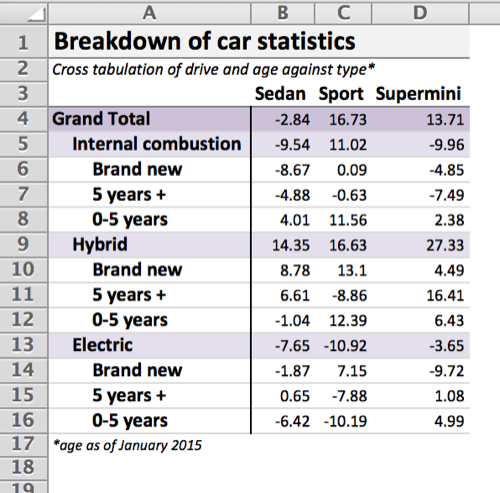
This readme provides a variety of examples of increasing complexity. It is based on a simulated dataset built into the package, which you can see here.
Getting started
Much of xltabr utility comes from its ability to automatically format cross tabulations which have been produced by reshape2:dcast.
The package provides a core convenience function called xltabr::auto_crosstab_to_xl. This wraps more advanced functionality, at the cost of reducing flexibility.
The following code assumes you've read in the synthetic data as follows:
# Read in data path <- system.file ( "extdata" , "synthetic_data.csv" , package = "xltabr" ) df <- read.csv ( path , stringsAsFactors = FALSE ) Example 1: Simple cross tabulation to Excel
# Create a cross tabulation using reshape2 ct <- reshape2 :: dcast ( df , drive + age ~ type , value.var = "value" , margins = c ( "drive" , "age" ), fun.aggregate = sum ) ct <- dplyr :: arrange ( ct , - row_number ()) # Use the main convenience function from xltabr to output to excel tab <- xltabr :: auto_crosstab_to_wb ( ct , return_tab = TRUE ) #wb is an openxlsx workbook object openxlsx :: openXL ( tab $ wb ) 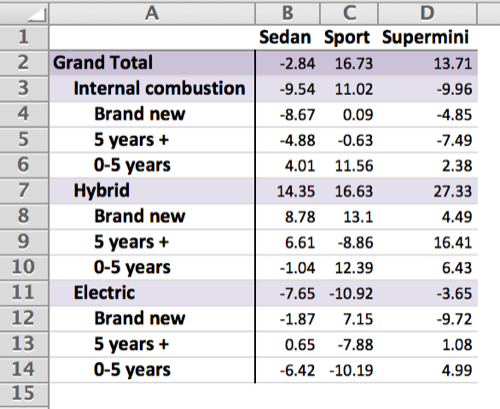
Example 2: Standard data frame to Excel
There is also a convenience function to write a standard data.frame to Excel:
wb <- xltabr :: auto_df_to_wb ( mtcars ) openxlsx :: openXL ( wb ) 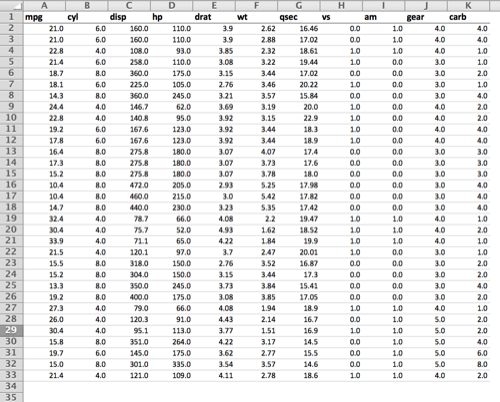
Example 3: Add in titles and footers
titles = c ( "Breakdown of car statistics" , "Cross tabulation of drive and age against type*" ) footers = "*age as of January 2015" wb <- xltabr :: auto_crosstab_to_wb ( ct , titles = titles , footers = footers ) openxlsx :: openXL ( wb ) 
Example 4: Supply custom styles
path <- system.file ( "extdata" , "styles_pub.xlsx" , package = "xltabr" ) cell_path <- system.file ( "extdata" , "style_to_excel_number_format_alt.csv" , package = "xltabr" ) xltabr :: set_style_path ( path ) xltabr :: set_cell_format_path ( cell_path ) wb <- xltabr :: auto_crosstab_to_wb ( ct ) openxlsx :: openXL ( wb ) 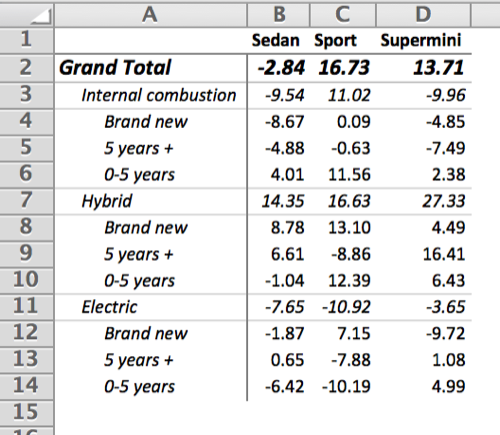
Example 5: Output more than one table
# Change back to default styles xltabr :: set_style_path () xltabr :: set_cell_format_path () # Create second crosstab ct2 <- reshape2 :: dcast ( df , drive + age ~ colour , value.var = "value" , margins = c ( "drive" , "age" ), fun.aggregate = sum ) ct2 <- dplyr :: arrange ( ct2 , - row_number ()) tab <- xltabr :: auto_crosstab_to_wb ( ct , titles = titles , footers = c ( footers , "" ), return_tab = TRUE ) titles2 = c ( "Table 2: More car statistics" , "Cross tabulation of drive and age against colour*" ) footers2 = "*age as of January 2015" wb <- xltabr :: auto_crosstab_to_wb ( ct2 , titles = titles2 , footers = footers2 , insert_below_tab = tab ) openxlsx :: openXL ( wb ) 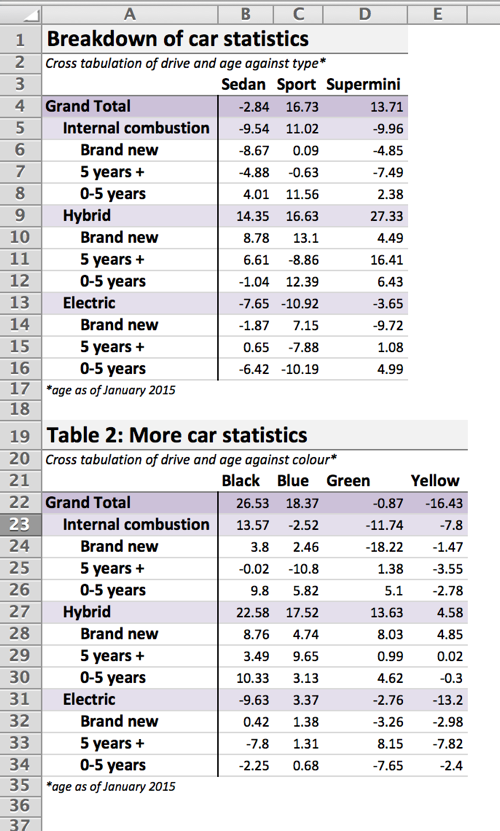
Example 6: Output more than one table, with different styles
tab <- xltabr :: auto_crosstab_to_wb ( ct , titles = titles , footers = c ( footers , "" ), return_tab = TRUE ) xltabr :: set_style_path ( path ) xltabr :: set_cell_format_path ( cell_path ) wb <- xltabr :: auto_crosstab_to_wb ( ct2 , titles = titles2 , footers = footers2 , insert_below_tab = tab ) openxlsx :: openXL ( wb ) # Change back to default styles xltabr :: set_style_path () xltabr :: set_cell_format_path () 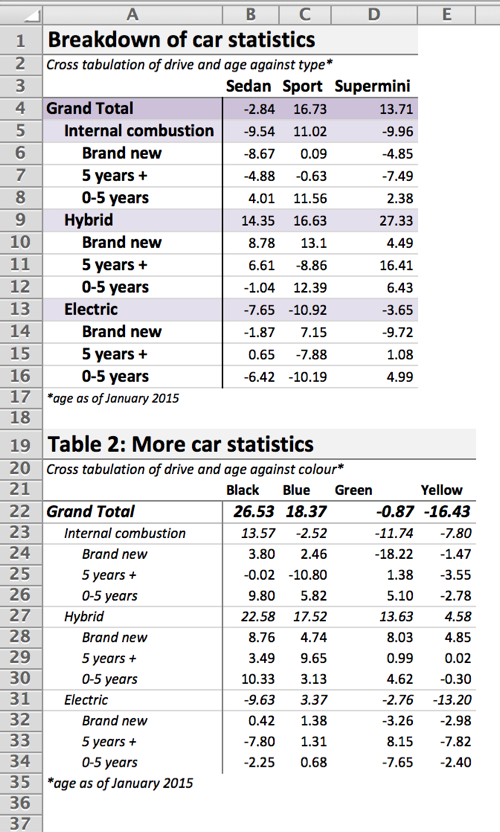
Example 7: Auoindent off
ct <- reshape2 :: dcast ( df , drive + age ~ type , value.var = "value" , fun.aggregate = sum ) wb <- xltabr :: auto_crosstab_to_wb ( ct , titles = titles , footers = c ( footers , "" ), indent = FALSE , left_header_colnames = c ( "drive" , "age" )) openxlsx :: openXL ( wb ) 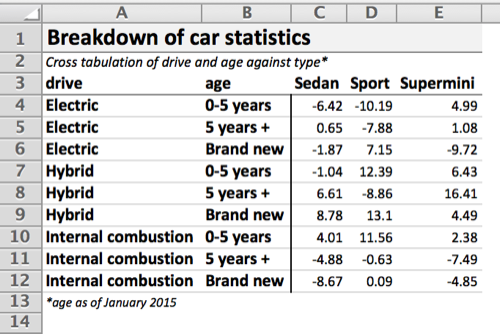
auto_crosstab_to_wb options
The following provides a list of all the options you can provide to auto_crosstab_to_wb
## Take a cross tabulation produced by 'reshape2::dcast' and output a formatted openxlsx wb object ## ## Description: ## ## Take a cross tabulation produced by 'reshape2::dcast' and output a formatted openxlsx wb object ## ## Usage: ## ## auto_crosstab_to_wb(df, auto_number_format = TRUE, top_headers = NULL, ## titles = NULL, footers = NULL, auto_open = FALSE, indent = TRUE, ## left_header_colnames = NULL, vertical_border = TRUE, return_tab = FALSE, ## auto_merge = TRUE, insert_below_tab = NULL, total_text = NULL, ## include_header_rows = TRUE, wb = NULL, ws_name = NULL, ## number_format_overrides = list(), fill_non_values_with = list(na = NULL, ## nan = NULL, inf = NULL, neg_inf = NULL), allcount_to_level_translate = NULL, ## left_header_col_widths = NULL, body_header_col_widths = NULL) ## ## Arguments: ## ## df: A data.frame. The cross tabulation to convert to Excel ## ## auto_number_format: Whether to automatically detect number format ## ## top_headers: A list. Custom top headers. See 'add_top_headers()' ## ## titles: The title. A character vector. One element per row of title ## ## footers: Table footers. A character vector. One element per row of footer. ## ## auto_open: Boolean. Automatically open Excel output. ## ## indent: Automatically detect level of indentation of each row ## ## left_header_colnames: The names of the columns that you want to designate as left headers ## ## vertical_border: Boolean. Do you want a left border? ## ## return_tab: Boolean. Return a tab object rather than a openxlsx workbook object ## ## auto_merge: Boolean. Whether to merge cells in the title and footers to width of body ## ## insert_below_tab: A existing tab object. If provided, this table will be written on the same sheet, below the provided tab. ## ## total_text: The text that is used for the 'grand total' of a cross tabulation ## ## include_header_rows: Boolean - whether to include or omit the header rows ## ## wb: A existing openxlsx workbook. If not provided, a new one will be created ## ## ws_name: The name of the worksheet you want to write to ## ## number_format_overrides: e.g. list("colname1" = "currency1") see auto_style_number_formatting ## ## fill_non_values_with: Manually specify a list of strings that will replace non numbers types NA, NaN, Inf and -Inf. e.g. list(na = '*', nan = '', inf = '-', neg_inf = '-'). Note: NaNs are not treated as NAs. ## ## allcount_to_level_translate: Manually specify how to translate summary levels into header formatting ## ## left_header_col_widths: Width of row header columns you wish to set in Excel column width units. If singular, value is applied to all row header columns. If a vector, vector must have length equal to the number of row headers in workbook. Use special case "auto" for ## automatic sizing. Default (NULL) leaves column widths unchanged. ## ## body_header_col_widths: Width of body header columns you wish to set in Excel column width units. If singular, value is applied to all body columns. If a vector, vector must have length equal to the number of body headers in workbook. Use special case "auto" for ## automatic sizing. Default (NULL) leaves column widths unchanged. ## ## Examples: ## ## crosstab <- read.csv(system.file("extdata", "example_crosstab.csv", package="xltabr")) ## wb <- auto_crosstab_to_wb(crosstab) ## Advanced usage
The simple examples above wrap lower-level functions. These functions can be used to customise the output in a number of ways.
The following example shows the range of functions available.
tab <- xltabr :: initialise () %>% #Options here for providing an existing workbook, changing worksheet name, and position of table in wb xltabr :: add_title ( title_text ) %>% # Optional title_style_names allows user to specify formatting xltabr :: add_top_headers ( h_list ) %>% # Optional row_style_names and col_style_names allows custom formatting xltabr :: add_body ( df ) %>% #Optional left_header_colnames, row_style_names, left_header_style_names col_style names xltabr :: add_footer ( footer_text ) %>% # Optional footer_style_names xltabr :: auto_detect_left_headers () %>% # Auto detect left headers through presence of keyword, default = '(all)' xltabr :: auto_detect_body_title_level () %>% # Auto detect level of emphasis of each row in body, through presence of keyword xltabr :: auto_style_indent () %>% # Consolidate all left headers into a single column, with indentation to signify emphasis level xltabr :: auto_merge_title_cells () %>% # merge the cells in the title xltabr :: auto_merge_footer_cells () # merge the cells in the footer The convenience functions contain further examples of how to build up a tab. See here.
Implementation diagrams.
See here
How To Create A Crosstab In Excel
Source: https://moj-analytical-services.github.io/xltabr/
Posted by: dellingerknobson.blogspot.com

0 Response to "How To Create A Crosstab In Excel"
Post a Comment